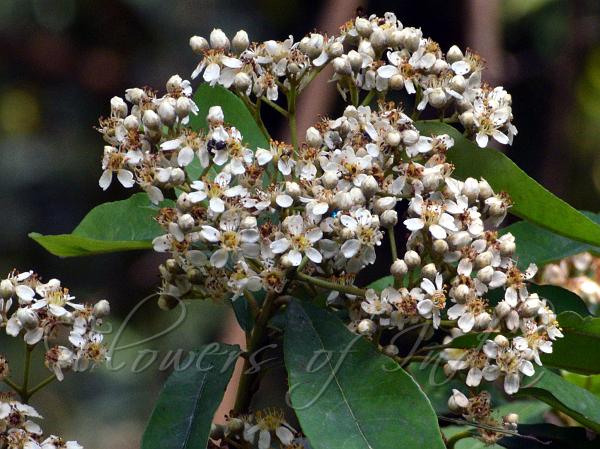|
| Indo-China Chokeberry |
|

|

| File size | 1086703 |
| Original date | 5/18/22 10:38 AM |
| Resolution | 5210 x 3062 |
| Flash | Flash did not fire |
| Focal length | 300.0mm |
| Exposure time | 1/160s |
| Aperture | 13.0 |
| Focus Distance | |
| Metering Mode | Center weighted average |
| Camera make | NIKON CORPORATION |
| Camera model | NIKON D5300 |
| Sensor type | OneChipColorArea |
|
|
|
|
Photo: |
Botanical name: Stranvaesia nussia Family: Rosaceae (Rose family)
Synonyms: Photinia nussia, Pyrus nussia, Stranvaesia glauca
Synonyms: Photinia nussia, Pyrus nussia, Stranvaesia glauca
Indo-China Chokeberry is a small tree up to 5-9 m
tall. Branchlets are purplish brown when old, round, densely hairy when
young, gradually becoming hairless, nearly hairless when old.
Leaf-stalks are about 1 cm, hairy; stipules falling off, lanceshaped,
membranous. Leaves are inverted-lanceshaped or obovate-lanceshaped, 6-8
x 2-3.5 cm, veins 10-12 pairs, below hairy along veins, above initially
hairy, becoming hairless, base wedge-shaped, margin irregularly bluntly
toothed, tip pointed. Flowers are borne in compound corymbs at
branch-ends, 6-9 x 8-12 cm, many flowered. Flowers are about 1 cm in
diameter. Petals are oblong or elliptic, 4-6 x 3-5 mm, base shortly
clawed and barbate, tip notched. Sepal-cup is bell-shaped, below hairy.
Sepals are triangular-lanceshaped, 2.5-4 x 2.5-3 mm, margin entire, tip
pointed. Stamens are 20; filaments unequal in length, slightly shorter
than sepals. Styles are 4 or5, fused for about 1/2 length, base densely
velvet-hairy. Axis and flower-stalks are densely hairy; bracts 4-6 mm,
velvet-hairy. Flower-stalks are 5-10 mm. Fruit is orangish red,
compressed-spherical, about 8 mm in diameter, velvet-hairy when young,
becoming hairless; sepals incurved. Indo-China Chokeberry is found in
mixed forests at altitudes of 500-2800 m, in NE India, China and SE
Asia.
| Identification credit: Ankit Yuvi Rawat, Sunit Singh | Photographed in Ukhimath, Uttarakhand. |
• Is this flower misidentified? If yes,